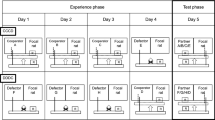Abstract
An experiment was carried out to assess the ability of captive western lowland gorillas (Gorilla g. gorilla) to exchange objects with a human partner. Before the exchange itself, individuals had to learn to give an item to the experimenter. Four individuals out of nine performed active giving. After that familiarization with giving behaviour, two kinds of exchanges, of increasing complexity, were tested with gorillas. Simple exchange (give C to obtain D) was the first procedure and six gorillas out of nine succeeded. Double exchange (give B to receive C, then give back C to obtain D) was performed only by three individuals and triple exchange (give A to receive B, give back B to receive C, then give back C to obtain D) was performed only by two individuals. Different types of errors were scored, as well as social constraints on learning. Results showed that (1) naive gorillas are able to get a reward (D) in an experimental exchange situation; and (2) the complex rules of multiple successive exchanges were not easily understood by gorillas.
Similar content being viewed by others
References
Bard, K. A. 1990. “Social tool use” by free-ranging orangutans: a Piagetian and developmental perspective on the manipulation of an animate object. In:“Language” and Intelligence in Monkeys and Apes,Parker,S. T.;Gibson,K. R. (eds.), Cambridge Univ. Press, New York, pp. 356–378.
Beck, B. B. 1980.Animal Tool Behavior: The Use and Manufacture of Tools by Animals. Garland STPM Press, New York.
Bertrand, M. 1976. Acquisition by a pigtail macaque of behavior patterns beyond the natural repertoire of the species.Zeitsch. Tierpsychol. 42: 139–169.
Boesch, C.;Boesch, H. 1989. Hunting behavior of wild chimpanzees in the Taï national park.Amer. J. Phys. Anthropol., 78: 547–573.
Byrne, R. W. 1996. The misunderstood ape: cognitive skills of the gorilla. In:Reaching into Thought: The Minds of the Great Apes,Russon,A. E.;Bard,K. A.;Parker,S. T. (eds.), Cambridge Univ. Press, Cambridge, pp. 111–130.
Chalmeau, R. 1994. Do chimpanzees cooperate in a learning task?Primates, 35: 385–392.
Chalmeau, R.;Gallo, A. 1996. Cooperation in primates: critical analysis of behavioural criteria.Behav. Process., 35: 101–111.
Chalmeau, R.;Lardeux, K.;Brandibas, P.;Gallo, A. 1997. Cooperative problem solving by orangutans (Pongo pygmaeus).Int. J. Primatol., 18: 23–32.
Chalmeau, R.; Peignot, P. in press. Inter-individual spatial proximity in two captive groups of western lowland gorillas(Gorilla g. gorilla). Folia Primatologica.
Coussi-Korbel, S. 1993. Influences sociales sur l'acquisition et l'utilisation d'informations relatives à la recherche de nourriture dans un groupe de Cercocèbes (Cercocebus t. torquatus). Ph. D. thesis, Univ. de Rennes I.
De Waal, F. B. M. 1989. Food sharing and reciprocal obligations among chimpanzees.J. Human Evol., 18: 433–459.
De Waal, F. B. M. 1992. Appeasement, celebration, and food sharing in the twoPan species. In:Human Origins,Nishida,T.;McGrew,W. C.;Marler,P.;Pickford,M.;De Waal,F. (eds.), Univ. of Tokyo Press, Tokyo, pp. 37–50.
De Waal, F. B. M.;Luttrell, L. M.;Canfield, M. E. 1993. Preliminary data on voluntary food sharing in brown capuchin monkeys.Amer. J. Primatol., 29: 73–78.
Fontaine, B.;Moisson, P. Y.;Wickings, E. J. 1995. Observations of spontaneous tool making and tool use in a captive group of Western Lowland Gorillas (Gorilla gorilla gorilla).Folia Primatol. 65: 219–223.
Galdikas, B. M. F. 1989. Orangutan tool use.Science, 243: 152.
Galdikas, B. M. F.;Teleki, G. 1981. Variation in subsistence activities of female and male pongids.Cur. Anthropol., 22(3): 241–256.
Goodall, J. 1963. My life among wild chimpanzees.Nat. Geogr. 124: 272–308.
Goodall, J. 1986.The Chimpanzees of Gombe. Belknap Press, Cambridge.
Horr, D. 1977. Orangutan maturation: growing up in a female world. In:Primate Biosocial Development,Chevalier-Skolnikoff,S.;Poirier,F. (eds.), Garland Press, New York, pp. 289–321.
Lefebvre, L. 1982. Food exchange strategies in an infant chimpanzee.J. Human Evol., 11: 195–204.
Lethmate, J. 1982. Tool-using skills of orang-utans.J. Human. Evol., 11: 49–64.
MacKinnon, J. 1974. The behaviour and ecology of wild orangutans (Pongo pygmaeus).Anim. Behav., 22: 3–74.
Mauss, M. 1950.Sociologie et Anthropologie. Presses Universitaires de France, Paris.
Parker, S. T. 1994. Incipient mirror-self-recognition in zoo gorillas and chimpanzees. In:Self-awareness in Animals and Humans: Developmental Perspectives,Parker,S. T.;Mitchell,R. W.;Boccia,M. L. (eds.), Cambridge Univ. Press, New York, pp. 301–307.
Parker, S. T.;Gibson, K. R. 1977. Object manipulation, tool use and sensorimotor intelligence as feeding adaptations in Cebus monkeys and great apes.J. Human. Evol., 6: 623–641.
Patterson, F. G. P.;Cohn, R. H. 1994. Self-recognition and self-awareness in lowland gorillas. In:Selfawareness in Animals and Humans: Developmental Perspectives,Parker,S. T.;Mitchell,R. W.;Boccia,M. L. (eds.), Cambridge Univ. Press, New York, pp. 273–290.
Russon, A. E.;Bard, K. A.;Parker, S. T. 1996.Reaching into Thought: The Minds of the Great Apes Cambridge Univ. Press, Cambridge.
Stoczkowski, W. 1994.Anthropologie Naïve, Anthropologie Savante. CNRS Editions, Paris.
Suarez, S. D.;Gallup, G. G. 1981. Self-recognition in chimpanzees and orangutans but not gorillas.J. Human Evol., 10: 175–188.
Teleki G. 1973.The Predatory Behavior of Wild Chimpanzees. Bucknell Univ. Press, Lewisburg.
Author information
Authors and Affiliations
About this article
Cite this article
Chalmeau, R., Peignot, P. Exchange of objects between humans and captive western lowland gorillas. Primates 39, 389–398 (1998). https://doi.org/10.1007/BF02557563
Received:
Accepted:
Issue Date:
DOI: https://doi.org/10.1007/BF02557563




